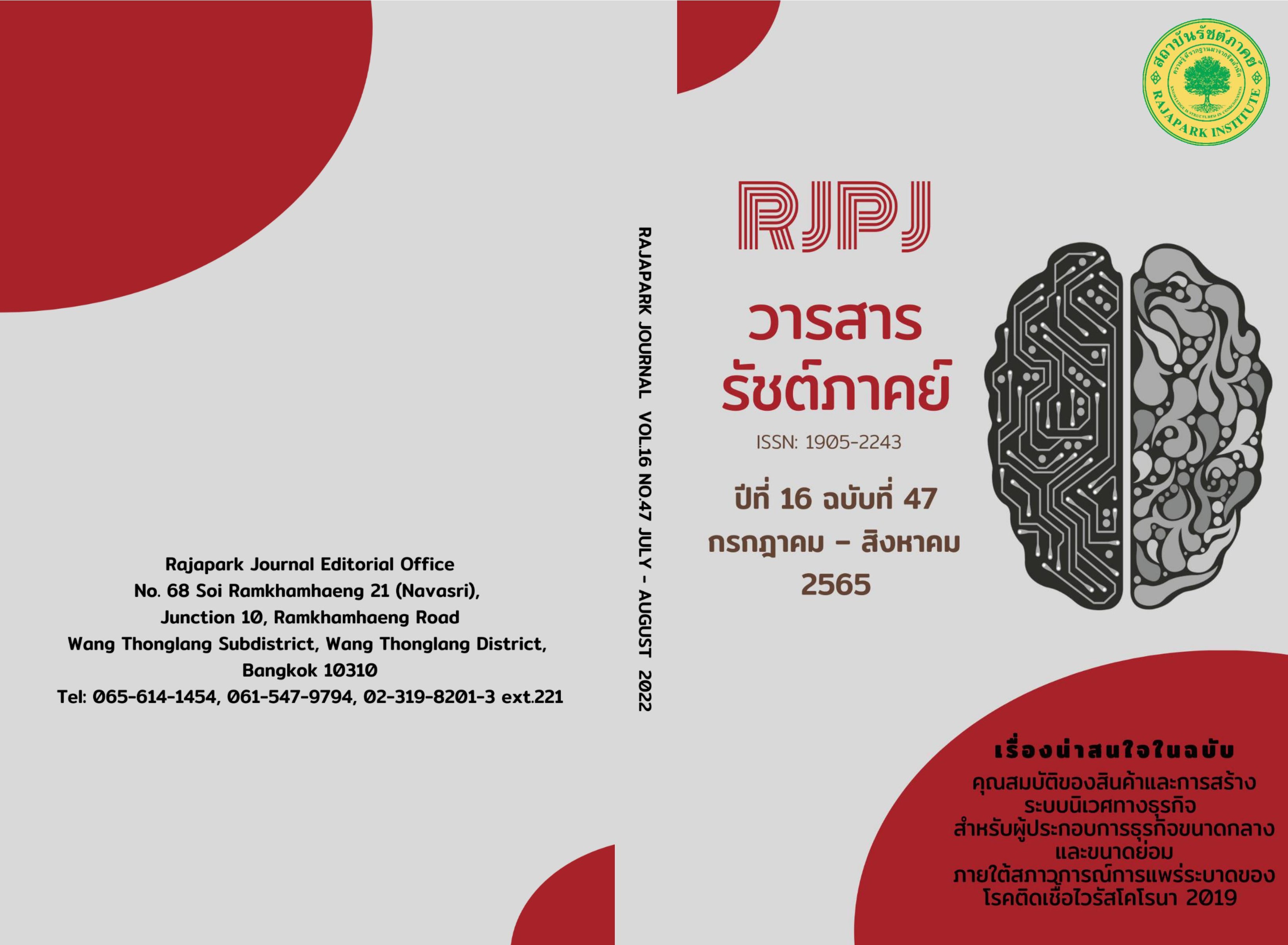The Effect of Organization Commitment and Its Antecedents on Employee Retention of Myanmar Workers in Samutsakorn Province
Main Article Content
Abstract
This article aimed to study the impact of each variable on quality of work life (QWL), training and development program (TND), job satisfaction (JS), and organizational commitment (OC) to employee retention (ER) of Myanmar workers in Samutsakorn Province. It was a mixed method that focused on quantitative and qualitative data collection. Qualitative data were used by in-depth interviews with key informants who are experts, total of 12 cases to confirm the idea from the interview to draw conclusions from the research. Quantitative data was collected by a questionnaire from 616 Myanmar workers in the seafood processing industry in Samutsakorn Province. Analyze the data by Structural Equation Modeling (SEM) Program. Data were collected using questionnaires that passed reliability-tested questionnaires, Cronbach’s Alpha ≥ .70 and Corrected Item-Total Correlation ≥ .30. The results of this research show that JS has the greatest influence on ER. Although negatively due to the COVID-19 situation, JS has no sufficient effect on employee retention. Due to the shortage of workers in every industry, workers have more choices to compare their benefits. Therefore, employee retention must take into account that QWL will affect TND, causing the Myanmar workers to have JS and OC, resulting in the workers' remaining in the organization.
Article Details

This work is licensed under a Creative Commons Attribution-NonCommercial-NoDerivatives 4.0 International License.
Views and opinions appearing in the Journal it is the responsibility of the author of the article, and does not constitute the view and responsibility of the editorial team.
References
Astrianti, A., Najib, M., & Sartono, B. (2020). Quality of Work Life, Organization Commitment and Turnover Intention in Account Officer of Micro Finance Company. Sosiohumaniora, 22(1), 17-25. DOI:10.24198/sosiohumaniora.v22i1.23121
Best, J. W. (1981). Research in Education (4th ed.). Prentice-Hall.
Biason, R.S. (2020). The Effect of Job Satisfaction on Employee Retention. International Journal of Economics, Commerce and Management, 8(3), 405-413.
Chanthaphong, S., Singhaphong, P., & Lertpiantham, K. (2018, August 7). The Flow of Migrant Workers’ is Understandable, Accessible and Fair. MPG Economic Review, Bank of Thailand. https://www.bot.or.th/Thai/ResearchAndPublications/DocLib_/Article_7Aug2018.pdf
Chaudhary, S.N., & Bhaskar, P. (2016). Training and Development and Job Satisfaction Ineducation Sector. Journal of Resources Development and Management, 16, 42-45.
Chimmamee, M., & Wongboonsin, P. (2014). Social Capital and Human Capital Development of Burmese, Laotian and Cambodian Migrant Workers After Migration to Thailand. Journal of Social Research, 37(2), 195-242.
Easton, S., & Van Laar, D. (2013). QoWL (Quality of Working Life) - What, How, and Why?. Psychology Research, 3(10), 596-605. http://www.davidpublishing.com/show.html?14709
Eketu., C.A., & Friday, O.E. (2015). Social Intelligence and Employee Intention to Stay. International Journal of Novel Research in Marketing Management and Economics, 2(1), 27-34. DOI:10.2139/ssrn.3480576
Hussain, A., Asad M. Khan., & Hanif M. Khan. (2020). The Influence of Training and Development on Organizational Commitment of Academicians in Pakistan. Review of Economics and Development Studies, 6(1), 43-55. DOI: 10.47067/reads.v6i1.183
Jehanzeb, K., & Bashir, N.A. (2013). Training and Development Program and its Benefits to Employee and Organization: A Conceptual Study. European Journal of Business and Management, 5(2), 243-252.
Kulkarni, P.P. (2013). A Literature Review on Training and Development and Quality of Work Life. Researchers World-Journal of Arts, Science & Commerce, IV (2), 136-143.
Kemket, W. (2012). Research Methods in Behavioral Sciences. Chulalongkorn University.
Leerasiri, W. (2020). Tendency for Return Migration of Migrant Workers After Myanmar Reform. Political Science and Public Administration, 11(1), 1-34.
Nair, R., Parvathy., & Subash, T. (2019). Quality of Work Life and Job Satisfaction: A Comparative Study. International Journal of Business and Management Invention (IJBMI), 8(2) Series. I, 15-21. https://www.ijbmi.org/papers/Vol(8)2/Series.%20I/C0802011521.pdf
Noor, A., Zainuddin, Y., Panigrahi, S.K., & Rahim, F.B.T. (2018). Investigating the Relationship Among Fit Organization, Organization Commitment and Employee’s Intention to Stay: Malaysian Context. Global Business Review, 21(1), 68-87. https://doi.org/10.1177/0972150918755896
Piemkla, P. (2015). Factors Influencing Burmese Return Migration and The Impact on Entrepreneurs In Kanchanaburi, Thailand. Thammasat University.
Pikulhom, S. (2018, December). Management of Migrant Workers in Thailand. The Secretariat of The House of Representatives. https://www.parliament.go.th/ewtadmin/ewt/parliament_ parcy/ewt_dl_link.php?nid=53887&filename=index
Prachachat. (2021, May 14). Labor Crisis, Shortage of 500,000 people “Industry-Agriculture-Services” Succumbs to COVID-19. Prachacha. https://www.prachachat.net/economy/news-666758.
Reddy, L.M., & Reddy, M.P. (2010). Quality of Work Life of Employees: Emerging Dimensions. Asian Journal of Management Research, 1, 829-839.
Siksamat, S., Chantapong, S., Buranathanung, N., Dasgupta, S., Bhula-or, R., Rodpengsangkaha, D., Tunsri, K., Yuenyeen, P., Jumnong, A., Siripanyawat S., & Laorkid, K. (2013). Thai Labour Market and its Role in Strengthening the Thai Economy. Statistics and Information
Department, Bank of Thailand.
Steers, R.M. (1977). Antecedents and Outcomes of Organizational Commitment. Administrative Science Quarterly, 22, 46-56.
Sulistiyowati, L.H. (2019). The Effect of Job Satisfaction to Organization Commitment, with the Development of a Career as Variable Intervening. Advances in Economics, Business and Management Research, 123, 99-102.
Thailand Development Research Institute Foundation. (2011). Industrial Capacity Building Project under Thailand's International Economic Policy (Phase 2) presented to the Office of Industrial Economics Ministry of Industry. Thailand Development Research Institute Foundation.
Thanwattanasiri, A. (2011). An Analysis of Problems in Employing Migrant Workers by Thai Construction Contractors. Chulalongkorn University Intellectual Repository (CUIR).
The Foreign Workers Administration Office, Ministry of Labor, Thailand. (2020). Statistics on the Number of Aliens Allowed to Work Throughout the Kingdom for August, 2020. https://www.doe.go.th/prd/assets/upload/files/alien_th/.
Vanichbuncha, K. (2011). Statistical Analysis. Chulalongkorn University.
Walton, R.E. (1974). Improving the Quality of Work Life. Harvard Business Review, 15(3), 33-34.
Walton, R.E. (1975). Criteria for Quality of Working Life. In L.E. Davis, and A.B. Cherms (Eds). The Quality of Working Life. Vol. 1. Free Press.
Yusoff, Y.M., Rimi, N.N., & Meng, C.H. (2015). A Study of Quality of Work Life, Organizational Commitment and Turnover Intention. Problems and Perspectives in Management, 13(2), 357-363. https://www.businessperspectives.org/images/pdf/applications/publishing/templates/article/assets/6751/PPM_2015_02spec.issue_M_Yusoff.pdf


